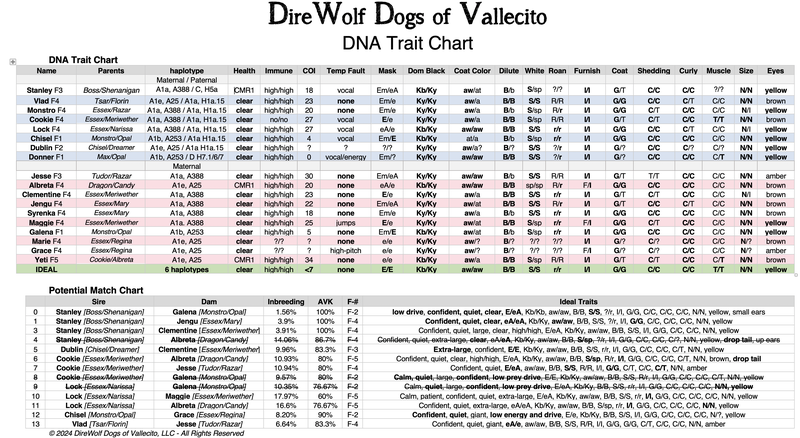Time for another breed-wide genetics update
By Jennifer Stoeckl, MAT - Dire Wolf Project CEO, May 17, 2024
Here at the Dire Wolf Project headquarters, we use:
- DNA,
- standardized temperament testing,
- observational data,
- “coefficient of inbreeding” (COI) and “ancestor loss coefficient” (AVK)
- ancestry information,
- blood tests, x-rays, and other health tests.
to make highly informed decisions about which dogs to breed to whom.
I capture most of this information in a large constantly updated document that I call a “trait chart”.
Then, I “test” certain potential matches combining all of the data to learn which matches work best for the future upcoming goals within the breed.
Here is the latest updated version for those more curious among you:

What exactly are the upcoming goals for the breed?
I’m so glad you asked.
The first thing we must always keep in mind is achieving the breed’s ideal.
Lois Schwarz, our breed founder, wrote the breed standard way back in 1987.
It’s been tweaked slightly here and there down through the years, but the current one is pretty close to the original.
Here’s a link for those interested in reading it:
https://direwolfproject.com/direwolf-dogs/direwolf-dogs-intl/standards-of-the-breeder/
The difficult thing for us, though, isn’t obtaining ONE DOG that matches the ideal.
It’s achieving AN ENTIRE BREED OF DOG that matches the ideal.
The good thing is that we have secured all of the outward appearance traits within the Dire Wolf Project that we need to achieve the ultimate breed-wide goal of breeding back the exactly bone and body structure of the extinct, prehistoric dire wolf.
The problem is…
These essential traits that, when combined, presumably get us to our goals are scattered throughout the dogs kept for breeding.
Most of these “dire wolf” traits (if you will) are recessive, so we must meticulously breed out the dominant traits that mask them.
NOTE: When we speak about adhering to the dire wolf bone and body structure, we generally speak about the outward appearance of the breed, but please remember that health and temperament requirements must always be considered first.
With that said, we are currently working on:
- No barking. With the recent Lab/Shepherd crossbreed addition, we can definitely see the stark contrast to our quieter breed. I will be specifically working with that new line to choose naturally quiet puppies.
- Increased confidence. This is a delicate balance. We don’t want TOO confident and bold, as that causes the dogs to have a more entitled attitude with less of an understanding about adhering to spacial boundaries. Our dog breed is highly emotionally sensitive, which we revere, but we do also want to make sure our dogs will be brave and easier to socialize for the average family. It is a delicate, thin line between the two. So, we lean on increased confidence, but keeping boldness in check.
- The wolf mask. I believe this one feature alone will have a huge impact on shifting the breed’s outward appearance to a more wild one.
- Increase overall size. There are a few dogs who still hide a “small size” allele in the recessive. But, even with the majority of our dogs homozygous for large size, there is still one or more genes associated with giantism that is an unknown. We do have a few giant-sized dogs, though: Cookie Monster, Yeti, Jesse, Albreta, and Chisel. Now, we need to increase the percentage of giants moving forward.
- Highly slanted eyes. This one is really hard to keep and has been elusive. Not very many domesticated dogs have highly slanted eyes, so we don’t have many crossbreeds to choose from to achieve it. Since we always work on temperament over looks, we’ll have to see if we can continue to produce this trait. Only a small few show it: Dreamer, Jesse, and Yeti.
- Short, straight otter tail. Long, curled tails just keep popping up, but we work on this whenever we can. The dire wolf did have a longer tail compared to its body size than the gray wolf, so we have some wiggle room here, but still, the tail must be straight.
- No white spotting. Most wild canids, except for the African Painted Dog and some foxes, do not have white spotting. For the most part, this is a domesticated trait. The Fox Farm experiments in Russia saw more and more white spotting over time as their foxes became friendlier and friendlier. The same is seen in many different domesticated animals. For the Dire Wolf Project, it has proved to be somewhat difficult to completely eliminate from the breed. It’s not impossible, however, so we’ll keep working on it as we can.
There are a few others, like: massive, webbed paws; yellow eyes; erect ears; thicker bones; and long mane/tail that are being considered, as well.
EACH one of these traits is extremely difficult to mass produce because the Dire Wolf Project insists on ONLY using domesticated dogs holding ancient DNA to achieve our goals.
We do NOT, nor will we ever, breed in any modern wolf content into our dog breed.
Slow and steady wins the race.
We’re not in a hurry.
You can’t rush perfection.
The most dire wolf looking of our dogs are probably these:
https://direwolfproject.com/direwolf-dogs/see-our-direwolf-dogs/
But our 8.5 month old Yeti (Cookie/Albreta) is filling out magnificently, with those wolf cheeks I love.
Jennifer Stoeckl is the co-founder of the Dire Wolf Project, founder of the DireWolf Guardians American Dirus Dog Training Program, and owner/operator of DireWolf Dogs of Vallecito. She lives in the beautiful inland northwest among the Ponderosa pine forests with her pack of American Dirus dogs.